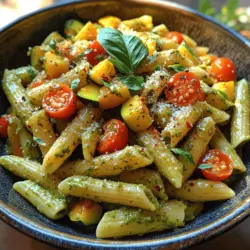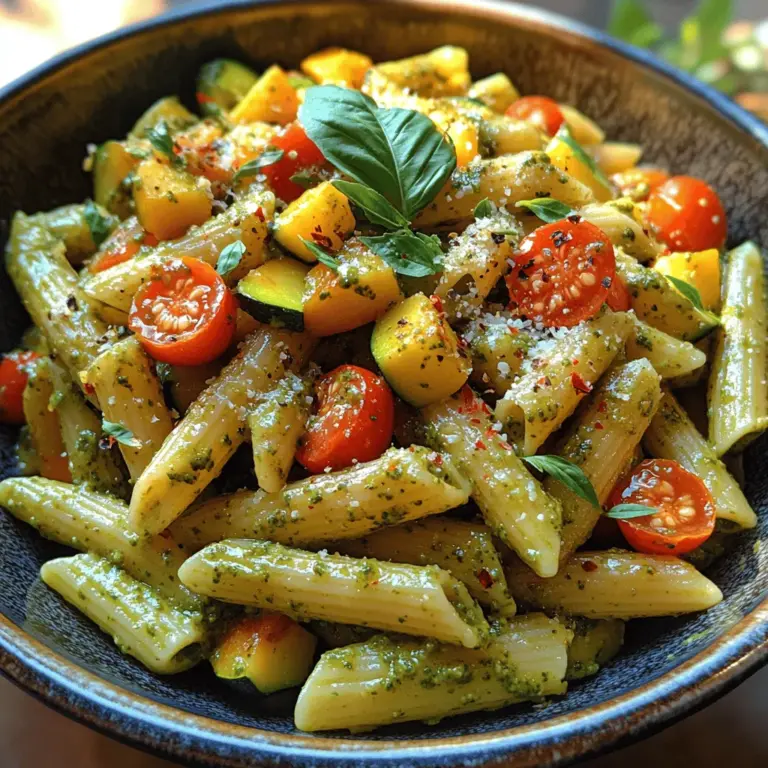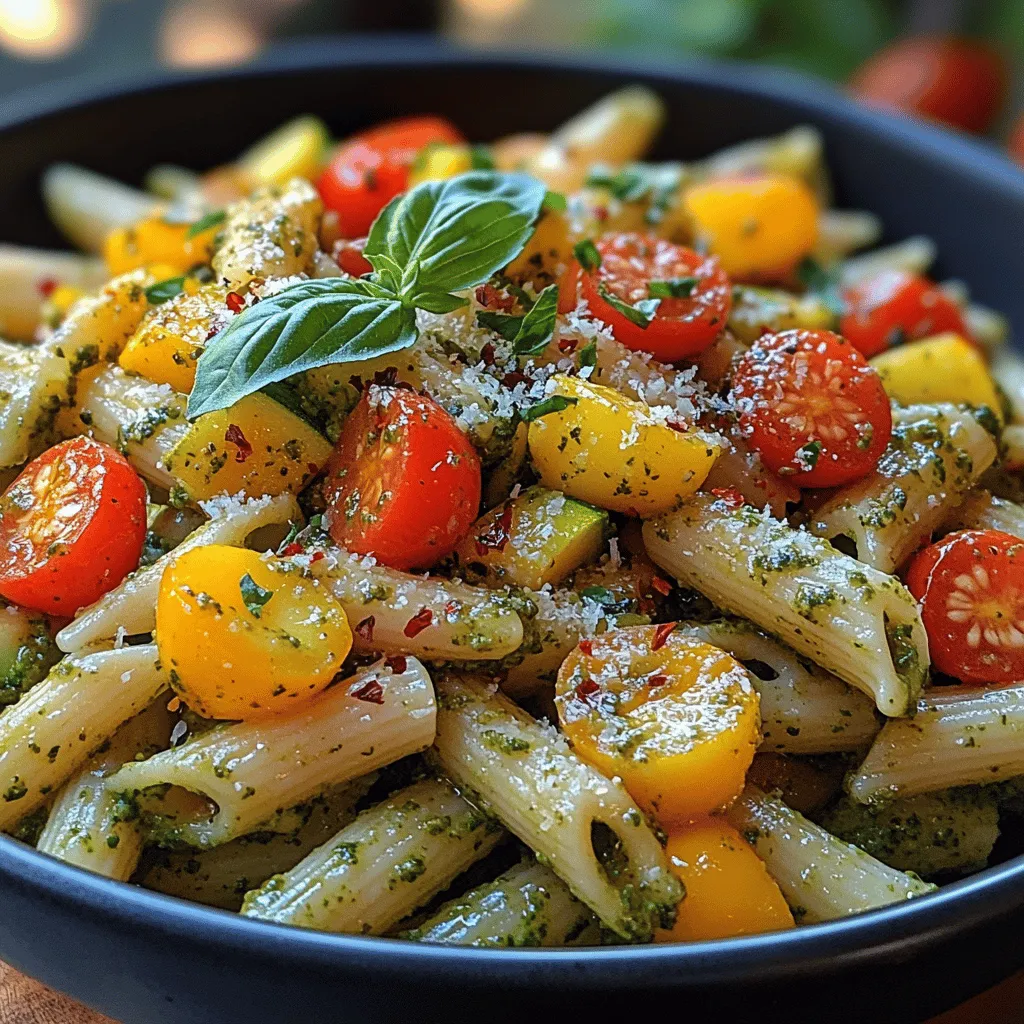As the sun shines brighter and gardens burst with life, there’s no better time to indulge in a dish that embodies the essence of summer: Vibrant Pesto Pasta with Summer Veggies. This delightful meal is not only visually appealing but also a celebration of fresh, seasonal ingredients that bring unparalleled flavor and nutrition to your table. Whether you’re enjoying a family gathering or a solo dinner, this dish promises to elevate your culinary repertoire while keeping your health in mind.
The Importance of Fresh, Seasonal Ingredients
One of the key elements that sets this Vibrant Pesto Pasta apart is its reliance on fresh, seasonal ingredients. In the summer months, produce is at its peak, bursting with flavor, color, and nutrients. Using seasonal vegetables like zucchini, red bell pepper, and cherry tomatoes not only enhances the dish’s taste but also supports local farmers and reduces your carbon footprint. These vegetables provide a medley of textures and vibrant hues, making your plate as appealing to the eyes as it is to the palate.
Moreover, incorporating fresh ingredients allows you to experience the true essence of the season. Each bite of this pasta dish is a reminder of sun-kissed gardens, farmers’ markets, and the rich culinary traditions that celebrate the bounty of summer. By choosing fresh produce, you’re not only ensuring a flavorful meal but also embracing a healthier lifestyle, packed with vitamins and minerals essential for your well-being.
How This Dish Embodies Summer Flavors and Healthy Eating
Vibrant Pesto Pasta with Summer Veggies is more than just a meal; it’s an experience that encapsulates the flavors of summer. The bright green basil in the pesto, combined with the sweetness of roasted cherry tomatoes and the crunch of fresh zucchini, creates a symphony of tastes that dance on your palate. Each ingredient complements the others, resulting in a dish that is both satisfying and light—a perfect representation of summer cooking.
In addition to its delightful flavors, this pasta dish is a champion of healthy eating. The use of whole grain pasta options, combined with nutrient-dense vegetables and homemade pesto, ensures that you’re not only enjoying a delicious meal but also nourishing your body. This recipe is rich in antioxidants, healthy fats, and fiber, making it an excellent choice for those looking to maintain a balanced diet while savoring the joys of summer.
The Allure of Pesto
History of Pesto and Its Italian Roots
Pesto, a traditional Italian sauce originating from Genoa, has a rich history that dates back to Roman times. The word “pesto” comes from the Italian word “pestare,” which means to crush or pound, referring to the original method of preparation using a mortar and pestle. The classic version of pesto, known as “pesto alla genovese,” is made from fresh basil, garlic, pine nuts, Parmesan cheese, and olive oil, all blended together to create a green, fragrant sauce.
Over the years, pesto has evolved beyond its traditional roots, inspiring numerous variations and adaptations worldwide. Its versatility allows it to be used in a variety of dishes, from pasta to sandwiches, pizza, and even as a marinade for meats and vegetables. This adaptability has contributed to its enduring popularity and the endless possibilities for culinary creativity.
The Versatility of Pesto in Various Dishes
What makes pesto truly special is its versatility. While it’s classically paired with pasta, this vibrant sauce can elevate countless dishes. Consider spreading pesto on toasted bread for a quick appetizer, drizzling it over grilled vegetables, or using it as a dressing for salads. The bright flavors of pesto can transform ordinary meals into extraordinary ones, making it a staple in many kitchens.
Additionally, pesto can be tailored to suit different dietary preferences. Whether you choose to make it nut-free, dairy-free, or even experiment with different herbs such as cilantro or arugula, the possibilities are endless. This adaptability not only caters to various tastes but also allows home cooks to get creative in the kitchen.
Nutritional Benefits of Basil and Nuts in Pesto
Beyond its delicious flavor, pesto is also packed with nutritional benefits. Basil, the hero of any pesto recipe, is rich in antioxidants and essential oils that can help reduce inflammation and combat oxidative stress. It also provides a good source of vitamins A, K, and C, contributing to overall health and wellness.
Nuts, typically pine nuts or walnuts, add both flavor and texture to pesto, while also offering their own array of health benefits. Nuts are a great source of healthy fats, protein, and fiber, making them a valuable addition to any diet. They contain essential nutrients, such as magnesium and vitamin E, which support heart health and promote healthy skin.
By incorporating pesto into your meals, you not only enjoy its vibrant taste but also reap the nutritional rewards of its wholesome ingredients.
Essential Ingredients for Vibrant Pesto Pasta
To create the perfect Vibrant Pesto Pasta, it’s crucial to gather high-quality ingredients that will work harmoniously together. Here’s a breakdown of the essential components that make this dish shine:
Pasta Options: Penne and Fusilli
When it comes to choosing pasta for this dish, options like penne and fusilli are ideal due to their unique shapes that hold onto the pesto beautifully. Penne, with its tubular structure, allows the sauce to cling to the pasta, ensuring each bite is packed with flavor. Fusilli, on the other hand, has spirals that catch the pesto and vegetables, creating a delightful texture that enhances your dining experience. Both options are versatile and can easily be found in whole-grain varieties for a healthier choice.
Fresh Basil: The Heart of the Pesto
Fresh basil is the star of the show when it comes to pesto. Its aromatic leaves provide the distinct flavor that characterizes this sauce. Look for vibrant, dark green basil leaves, as they will yield the best taste. When preparing the pesto, be sure to use a generous amount of fresh basil to impart that signature herbaceous flavor that pairs so well with pasta and vegetables.
Nuts: Pine Nuts or Walnuts
Nuts play a crucial role in the texture and flavor profile of pesto. Traditionally, pine nuts are the go-to choice, providing a buttery taste that blends seamlessly with the basil. However, walnuts can also be used for a more robust flavor and a slightly different texture. Both options offer healthy fats and protein, making them an essential component of the dish. If you’re looking for a budget-friendly alternative, walnuts are often more affordable than pine nuts and can deliver a deliciously nutty flavor.
Parmesan Cheese: Enhancing the Umami Flavor
Adding Parmesan cheese to your pesto not only enhances its richness but also provides a savory umami flavor that elevates the entire dish. When selecting cheese, opt for freshly grated Parmesan for the best taste and texture. The saltiness of the cheese will complement the freshness of the basil and the earthiness of the nuts, creating a well-balanced sauce that’s bursting with flavor.
Garlic: Adding Depth and Aroma
Garlic is another key ingredient in pesto, adding depth and aroma to the sauce. Fresh garlic cloves bring a sharp, pungent flavor that balances the sweetness of the basil and the nuttiness of the pine nuts or walnuts. When preparing your pesto, be sure to use fresh garlic rather than pre-minced options, as the flavor will be far superior.
Extra-Virgin Olive Oil: Health Benefits and Flavor
Extra-virgin olive oil is the backbone of pesto, providing a smooth, rich texture that ties all the ingredients together. It also brings a fruity flavor that enhances the overall taste of the sauce. Beyond its culinary benefits, extra-virgin olive oil is known for its health properties, including heart-healthy monounsaturated fats and antioxidants. When selecting olive oil, look for high-quality, cold-pressed varieties for the best flavor.
Seasonal Vegetables: Zucchini, Red Bell Pepper, Cherry Tomatoes, Yellow Squash
The seasonal vegetables in this dish not only add color and nutrition but also contribute to the overall flavor profile. Zucchini and yellow squash provide a mild sweetness and a pleasant crunch, while red bell peppers add a pop of color and a hint of sweetness. Cherry tomatoes, when roasted, become succulent and intensify in flavor, creating a delicious contrast to the fresh vegetables. Together, these ingredients create a vibrant medley that enhances the pasta and pesto.
Seasoning Essentials: Salt, Pepper, and Optional Red Pepper Flakes
To bring all the flavors together, don’t forget the essential seasonings: salt and pepper. These simple ingredients enhance the natural flavors of the vegetables and the pesto, making each bite more enjoyable. For those who appreciate a bit of heat, adding red pepper flakes is an excellent way to give the dish an extra kick.
Step-by-Step Preparation of Vibrant Pesto Pasta
Now that we’ve gathered all the necessary ingredients, it’s time to dive into the preparation of Vibrant Pesto Pasta with Summer Veggies. The first step in this flavorful journey is cooking the pasta to perfection.
Cooking the Pasta
Begin by bringing a large pot of salted water to a rolling boil. The salt not only flavors the pasta but also helps to prevent it from becoming sticky. Once the water is boiling vigorously, add your choice of pasta—penne or fusilli—and cook according to the package instructions until al dente.
Al dente pasta is key here, as it provides a firm texture that holds up well to the sauce. Stir occasionally to prevent sticking and ensure even cooking. Once the pasta is ready, reserve about a cup of pasta water before draining it in a colander. This starchy water will be useful later for adjusting the consistency of your pesto sauce.
As the pasta cooks, you can take this opportunity to prepare the vibrant summer vegetables that will accompany the dish.
Stay tuned for the next part, where we will dive deeper into making the pesto sauce and combining all the elements for a delightful summer meal!
Tips for Achieving Perfect Al Dente Pasta
Cooking pasta to perfection is an essential skill in creating a delightful pesto pasta dish. Al dente, which means “to the tooth” in Italian, refers to pasta that is cooked until it is firm to the bite. Here are some tips to ensure your pasta reaches this ideal texture:
1. Use Plenty of Water: A large pot of boiling water (about 4-6 quarts for every pound of pasta) is crucial. This helps prevent the pasta from sticking together and allows it to cook evenly.
2. Salt the Water: Generously salting the water before boiling enhances the flavor of the pasta. Aim for about 1-2 tablespoons of salt per gallon of water. The water should taste a bit like the sea.
3. Timing is Key: Follow the package instructions for cooking time, but start checking your pasta 2-3 minutes before the suggested time. The best way to test for doneness is to taste it. The pasta should be cooked through but still have a slight firmness at the center.
4. Shock It Quickly: Once your pasta is cooked, drain it immediately and, if you’re not mixing it with sauce right away, rinse it briefly under cold water to stop the cooking process. This helps maintain that perfect al dente texture.
Importance of Reserving Pasta Water for Sauce Consistency
One of the secrets to a luscious, cohesive sauce is the starchy pasta water. When you drain your pasta, set aside a cup of this water before discarding the rest. Here’s why it’s beneficial:
– Adjusting Sauce Thickness: The starch in the pasta water helps the pesto to cling to the pasta, creating a silky sauce. If your pesto seems too thick, adding a splash of reserved pasta water can help loosen it without losing flavor.
– Enhancing Flavor: The salted pasta water carries some flavor, which enhances the overall taste of the dish when mixed in with the sauce.
Crafting the Perfect Pesto
A vibrant pesto is the heart of this dish. Making it from scratch ensures a fresh and flavorful experience. Here’s how to create the perfect pesto using a food processor:
Detailed Instructions for Making Pesto in a Food Processor
1. Gather Ingredients: For a classic basil pesto, you will need:
– 2 cups fresh basil leaves, packed
– 1/2 cup grated Parmesan cheese
– 1/3 cup pine nuts (or walnuts for a twist)
– 2-3 cloves garlic, minced
– 1/2 cup extra virgin olive oil
– Salt and pepper to taste
– A squeeze of lemon juice (optional for brightness)
2. Blend the Basil and Nuts: In your food processor, combine the basil, nuts, and garlic. Pulse until coarsely chopped.
3. Incorporate Cheese: Add the grated Parmesan and pulse a few more times until combined.
4. Add Olive Oil: With the food processor running, slowly drizzle in the olive oil until the mixture is smooth and creamy. Scrape down the sides as needed to ensure everything is well mixed.
5. Season: Taste the pesto and add salt, pepper, and lemon juice as desired. Adjust to your preference.
Techniques for Balancing Flavors in Pesto
Creating a well-balanced pesto relies on the harmony of flavors. Here are some techniques:
– Experiment with Nuts: While pine nuts are traditional, try using almonds or cashews for a different flavor profile.
– Cheese Variations: Mixing different cheeses, like Pecorino Romano with Parmesan, can add depth.
– Herb Blends: Incorporate other herbs like parsley or arugula for a unique twist. This not only diversifies the flavor but also enhances the color.
Sautéing the Summer Vegetables
The fresh summer vegetables elevate the dish’s flavor and texture. Here’s how to sauté them perfectly:
Importance of Cooking Vegetables to Retain Their Crispness
To achieve beautifully sautéed vegetables that still have a delightful crunch, follow these steps:
– High Heat: Use medium-high heat to quickly cook the vegetables without overcooking them.
– Cut Uniformly: Ensure that vegetables are cut into similar sizes to promote even cooking.
– Don’t Overcrowd the Pan: Sauté in batches if necessary. Overcrowding causes steaming instead of sautéing, resulting in soggy vegetables.
Timing for Adding Ingredients for Optimal Flavor
When sautéing, timing is crucial. Start with harder vegetables like bell peppers and zucchini, which take longer to cook. Add quicker-cooking vegetables, like cherry tomatoes or asparagus, later in the process to ensure they maintain their vibrant color and crispness.
Combining Ingredients for the Ultimate Experience
Now that you’ve cooked your pasta, made the pesto, and sautéed the veggies, it’s time to combine everything for a beautiful dish.
Techniques on How to Properly Mix Pasta, Pesto, and Vegetables
1. Combine in a Large Bowl: In a large mixing bowl, add the drained pasta and a generous amount of pesto.
2. Toss Gently: Use tongs or a spatula to toss the pasta with the pesto. Ensure every strand is coated without breaking the pasta.
3. Add Vegetables: Gently fold in the sautéed vegetables, ensuring they’re evenly distributed throughout the pasta.
4. Adjust Sauce Consistency with Reserved Pasta Water: If the mixture seems dry, gradually add reserved pasta water until you reach your desired consistency.
Serving Suggestions and Presentation
Presentation enhances the dining experience, so consider these tips for an attractive serving:
Tips for Plating the Dish Attractively
– Use a Large Serving Platter: Instead of individual plates, serve the pasta on a large platter to create a communal feel.
– Twirl the Pasta: Use a fork to twirl the pasta into nests on the plate. This adds height and visual interest.
Ideas for Garnishing: Fresh Basil and Parmesan Cheese
– Fresh Herbs: Scatter fresh basil leaves on top for a pop of color and freshness.
– Parmesan Shavings: Use a vegetable peeler to create thin shavings of Parmesan cheese for a touch of elegance.
Suggestions for Pairing with Sides or Drinks
– Sides: Pair your vibrant pesto pasta with a crisp green salad dressed with lemon vinaigrette to complement the dish’s freshness.
– Drinks: A light white wine, such as Pinot Grigio or Sauvignon Blanc, pairs beautifully with the flavors of the pesto. For a non-alcoholic option, consider sparkling water with a slice of lemon.
Nutritional Overview
This vibrant pesto pasta is not only delicious but also packed with health benefits. Here’s a closer look at the nutritional content:
Breakdown of the Health Benefits of Each Ingredient
– Pasta: Provides carbohydrates for energy and can be made from whole grains for added fiber.
– Basil: Rich in antioxidants, basil supports heart health and has anti-inflammatory properties.
– Garlic: Known for its immune-boosting properties, garlic can help reduce blood pressure and cholesterol levels.
– Nuts: Pine nuts are a source of protein, healthy fats, and magnesium, which supports muscle and nerve function.
– Vegetables: Summer veggies like zucchini and bell peppers are low in calories but high in vitamins and minerals.
Caloric Information and Nutrient Highlights
A typical serving of vibrant pesto pasta (with vegetables) can range from 400-600 calories, depending on portion size and ingredients used. This dish provides a balance of macronutrients, with carbohydrates from pasta, protein from nuts and cheese, and healthy fats from olive oil and nuts.
Discussion on the Importance of a Balanced Meal
This recipe exemplifies a balanced meal, combining complex carbohydrates, healthy fats, and a variety of vegetables. Eating a colorful array of vegetables ensures you receive a wide range of nutrients, vital for overall health.
Conclusion
Vibrant pesto pasta with summer veggies is a celebration of fresh ingredients and seasonal flavors. Its appeal lies in its freshness, flavor, and health benefits, making it a perfect dish for warm-weather dining. This recipe encourages you to embrace seasonal cooking, utilizing the best produce available to create a meal that not only satisfies but nourishes.
Gather your ingredients, follow these steps, and enjoy a bowl of this delightful pasta, rich in taste and color. Whether for a weeknight dinner or a special occasion, this vibrant dish is sure to impress and become a staple in your culinary repertoire.


